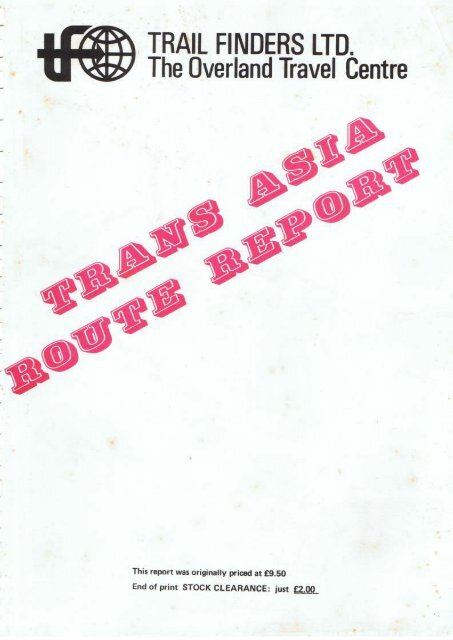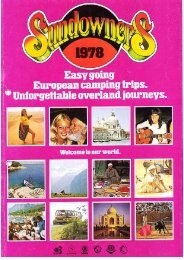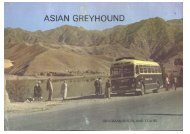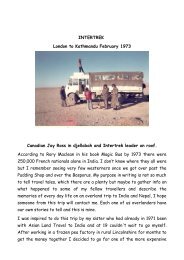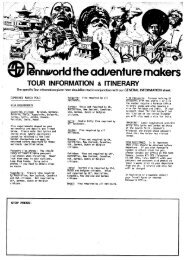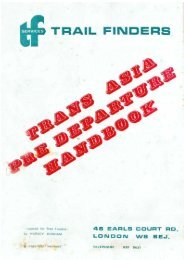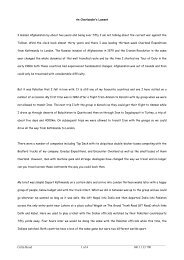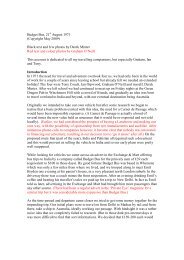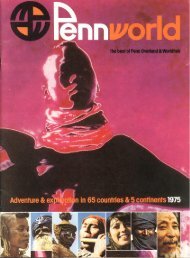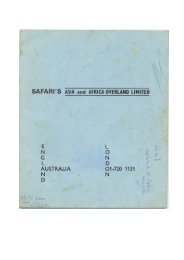Trans Asia Route Report - India Overland with Swagman Tours
Trans Asia Route Report - India Overland with Swagman Tours
Trans Asia Route Report - India Overland with Swagman Tours
Create successful ePaper yourself
Turn your PDF publications into a flip-book with our unique Google optimized e-Paper software.
PART 2<br />
With the guidelines offered in Part 1, you and your friends<br />
should be able to set about the purchase of a sound and<br />
suitable vehicle, spares, tools, camping, catering and medical<br />
kits. You will know how to cope <strong>with</strong> officialdom and budgeting.<br />
This section deals <strong>with</strong> your route.<br />
It would take a tony of paper to cover all the routes available<br />
and we have chosen those on which we have first—hand<br />
experience. You’ll find these variations are detailed for<br />
selected segments of the journeys as the chapter progresses.<br />
Our map guides will take you through Belgium, Germany,<br />
Austria, Yugoslavia, Greece, Bulgaria, Turkey, Syria,<br />
Lebanon, Jordan, Iraq, Afganistan, Pakistan, <strong>India</strong> and Nepal.<br />
Plus a few detours and optional extras.<br />
Like we said, it’s no polite Sunday school trip. Things will<br />
happen which cannot be forecast. It will be a tough test —<br />
demanding the full use of qualities you never thought to<br />
develop. At best it may be a breakdown (did you bring that<br />
spare and the necessary tools?) Or a brush <strong>with</strong> the law (why<br />
didn’t you fill up that form in London?). A cold night on the<br />
mountain. An earth tremor. An insect bite. At worst a political<br />
uprising (needing a fast flight home). By the nature of this<br />
kind of territory, Trail Finders would have to update its<br />
manual every day. Our aim is to give you the best and most<br />
current advice available — backed by the experience of men who<br />
travel these routes constantly.<br />
For the rest, it’s entirely up to you. Your equipment your<br />
planning ... your initiative (and diplomacy) ... and your reserves.<br />
A tall order but we guess that’s the heart of your reason for<br />
breaking out in the first place.
OSTENDE - MUNICH MAP 01<br />
Take the E5 to Gent then branch onto the E3 to Antwerpen, by-passing<br />
the centre and onto Liege. Here you join E5. Just before Aächen is the<br />
German customs post. Continue on the E5 through Koin, Frankfurt and<br />
onto Nurnberg. Take the E6 here to Munchen. This route is autobahn the<br />
entire way.<br />
TRAILFINDERS’ STOP PRESS:
MUNICH<br />
(Population - (1,250,000)<br />
Its artistic treasures and the number and reputation of its museums and<br />
theatres make Munich one of the artistic centres of Germany. Not to forget the<br />
famous Hofbrau House where litre jugs of Barvaria beer are just the thing<br />
after a long drive. (Be careful not to spend a week here).<br />
On the outskirts is the infamous Dachau concentration camp, now a memorial to<br />
those who perished there. Nearby is the Olympic Games complex.<br />
There are two main campsites in Munich. Taicherchan and Obermensing. The<br />
former is situated<br />
on the Garmisch road near the Zoo. The latter is just off the autobahn before<br />
you enter Munich.<br />
Prices:- 3.50 DM per person<br />
Car<br />
Both have all facilities available.<br />
MUNCHEN - AUSTRIAN/YUGOSLAV FRONTIER MAP 02<br />
From Munchen it’s signposted to the Salzburg autobahn - route Eli.<br />
SALZBtJRG:- A beautiful city set among the mountains famous for its<br />
annual music festivals. Mozart was born here.<br />
The route to Graz via Bad Ischl takes you through some of Austria’s<br />
most spectacular mountain scenery.<br />
From Salzburg take route 158 to Bad Ischl, then route 145 to Liezen.<br />
Along this route you’ll pass through many picturesque villages.<br />
<strong>Route</strong> 113 takes you from Liezen to St. Michael where you join the E7 to<br />
Bruk an dur Mur.<br />
At Bruk an dur Mur take the E93 passing through Graz to the Frontier.<br />
TPAILFINDERS’ STOP PRESS:
YUGOSLAVIA<br />
A collection of civilisations - each making their mark in agitated<br />
history - provide rich variety for today’s visitor to Yugoslavia. A<br />
monarchy since 1918, it has a mixed population of Serbs, Macedonians,<br />
Montenegrins, Croats, Albanians and Slovences.<br />
Customs: Apart from personal luggage and food necessary for the trip,<br />
you can bring in 2 cameras, 5 rolls of film, 1 cinecamera, 2 rolls of<br />
cine-film, 1 pair of binoculars, camping equipment, 200 cigarettes (or<br />
50 cigars), a bottle of wine and ¼ litre of spirits.<br />
Insurance: Green cards are recognised. Motorists arriving <strong>with</strong>out a<br />
Green Card may apply at the Border for insurance against 3rd party<br />
risks.<br />
Petrol: You can buy petrol coupons (issued by The Auto-Motor<br />
Association of Yugoslavia) at frontier crossing points: auto and<br />
touring clubs, travel agents and some banks. These can be traded for<br />
petrol at any station in the country (<strong>with</strong> some cost saving). Unused<br />
coupons may be cashed in at the place of issue or at frontier crossing<br />
points up to 31st March of the following year.<br />
Petrol stations are adequately provided in towns and on highways.<br />
Two kinds of petrol are sold — 98 octane (superior) and 86<br />
octane (premium)<br />
Roads: Vehicles are driven on the right side. Urban speed limit is 60<br />
kmp (37 mph). Elsewhere, there are no speed restrictions unless posted<br />
<strong>with</strong> signs.<br />
All main tourist roads are asphalt, flagged or concrete surfaced. The<br />
Adriatic Highway runs the length of the Adriatic Coast and, at<br />
Petrovac, turns inland to link <strong>with</strong> the Ibar Highway (Belgrade Skopje)<br />
at Kosovska-Mitrovja. There’s a lot to look at; forests gorges,<br />
canyons and rugged coastline.<br />
Camping: Permitted only in places designed as camping sites. There are<br />
plenty available and all marked clearly <strong>with</strong> the international camping<br />
symbol.<br />
Trail.Finders’ Tip: It’s so easy to pick up an on-the-spot fine from<br />
Yugoslavia’s traffic police. Watch highway corner cutting; good<br />
mannders at intersections; urban speed limits and whisky on your<br />
breath.<br />
TRAILFINDERS’ STOP PRESS:
AUSTRIAN/YUGOSLAV FRONTIER - BELGRADE MAP 04<br />
A bank is available at the customs post for you to exchange your<br />
travellers cheques and purchase petrol coupons.<br />
The road from the customs post to Zagreb is new autoput in good<br />
conditon. It passes through towns noted for their thermal springs.<br />
At Zagreb you join the main autoput.<br />
In places the surface has lifted, waiting for repairs. The general<br />
condition leaves something to be desired.<br />
The highway runs for its entire length through the Salvonian and Srem<br />
plains, <strong>with</strong> fields and forests. At the halfway point you may make a<br />
detour to the city of Slavonski Brod.<br />
Between Zagreb and Belgrade at approximately every 50 kims there are<br />
motels and petrol pumps on the highway.<br />
BELGRADE:- A very good campsite is situated on the outskirts of the<br />
city (signposted).<br />
TRAILFINDERS’ STOP PRESS:
BELGRADE<br />
The history of Belgrade, Yugoslavia’s capital, has been one of destruction and<br />
it’s a marvel it still stands as the modern capital.<br />
It was a fortified Celtish town in the fourth century B.C. and the Romans<br />
called it Singidunum. Completely destroyed in the following century it<br />
remained uninhabited for 100 years until rebuilt by the Emperor Justinian. The<br />
Slays occupied it in the 8th century and christened it Beograd, which has been<br />
Anglicised as Belgrade - the white town. It became a cultural centre and<br />
prospered under King Dragutin of Serbia.<br />
In 1521 the Turks captured it and some of their influence still remains for<br />
they stayed until 1867 when Serbia started as an independent state. During the<br />
eighteenth century it came under Austrian rule and the town was rebuilt in its<br />
imposing style.<br />
During the Second World War Belgrade suffered heavily but it has recovered and<br />
today is a cosmopolitan city of a million inhabitants <strong>with</strong> a fascinating<br />
mixture of population representing all the different peoples of Yugoslavia.
BELGRADE - YUGOSLAV/GREEK FRONTIER MAP 05<br />
The road from Belgrade leads first through hilly regions over a<br />
recently constructed highway. At 100 kilometers from Belgrade a detour<br />
can be made to Despotovac (36 kims). Here is the famous Manasija<br />
Monastery and the recently discovered Resavska Cave <strong>with</strong> beautiful<br />
stalagmites and stalagtites.<br />
The remainder of the autuput passes through rolling country to Nis.<br />
From Nis the autoput takes you to Leskovac. South of Leskovac the<br />
highway leads through the Grdelicka Gorge. A short detour takes you to<br />
Vranjska Banja where there is a thermal spa.<br />
Continuing southwards the road enters the Socialist Republic of<br />
Macedonia, then over the Skopska Crna Gora mountains before it reaches<br />
Skopje.<br />
SKOPJE:- In 1963 the town suffered a catastrophic earthquake. Parts<br />
have been left as a reminder.<br />
On entering Skopje you pass two very good campsites.<br />
From Skopje to the frontier the road passes through the Pcinja and<br />
Vardar gorges to Titor Veles. The remainder of the road to the border<br />
is through rolling country.<br />
RAILFINDERS STOP PRESS:
GREECE<br />
Many features of the Western World have their roots in the Greek civilisation —<br />
liturature, drama, logic and sports. Most visitors find it hard to credit that<br />
so much remains to be enjoyed today -despite the ravages or war and crude<br />
occupation through many centuries.. There was the Minoan civilisation in 2,800<br />
BC. Cyclacle 800 years later. Then the Mycenian culture. Next the growth of a<br />
distinct Greek influence from 1100 BC. Rome, Byzantium and finally the arrival<br />
of Turks in 1453. Independence was retrieved in 1821 but echoes of old<br />
suspicion still rumble between Greek and Turk over the Cyprus question.<br />
Customs: Few restrictions here. Personal effects are free and there’s a quota<br />
of 200 cigarettes, 50 cigars, 2 bottles of spirits and wine and 10 kilograms<br />
of food stuffs. Each of the following are to be declared on entry: camera<br />
(cine or still) radio, tape recorder, typewriter, binnoculars. Third party<br />
insurance is not compulsory.<br />
Fuel: Regular petrol (84—86 octane) 6.20 Drs, per litre Premium Petrol (94—96<br />
octane) 7.25 Drs per litre. Diesel from 2.20 Drs per l~itre.<br />
Roads: International traffic regulations apply. Traffic drives on the right.<br />
Maximum speeds are signposted. A new Expressway runs from Katerini to Athens<br />
and on to Patras, <strong>with</strong> toll booths at various intervals. Other main roads are<br />
in good condition and present no difficulty.<br />
Camping: It’s permissable to pitch a tent anywhere except in the proximity of a<br />
town or historic site. There are campsites in all parts of Greece run by the<br />
Automobile Touring Club (ELPA) and National Tourist Organisation, plus various<br />
ones run by private enterprise. Rates for overnight stays are around:-<br />
10 - 15 Drs per tent<br />
10 - 15 Drs per person<br />
10 - 15 Drs per car<br />
Trail Finders’ Tip: Best buys are woven fabrics, embroideries, small fabric<br />
bags and “flocates” (long pile rugs) around Delfi; knitwear from the Island of<br />
Mikonos; cedar wood carvings from Tripolis; pottery in the ancient style from<br />
Olympia. Greek styled sandals are also popular.<br />
I i
YUGOSLAV/GREEK FRONTIER - LARISSA MAP 11<br />
Formalities on the frontier are quickly dealt <strong>with</strong> here. Green Card<br />
insurance applies here.<br />
The road from the border to Alexandria via Gefira is in good<br />
condition. It is tarmac surfaced and normal two lane width.<br />
The Alexandria to Katerini road is in similar condition. At Katerini<br />
the expressway starts. Each toll gate is well marked. The expressway<br />
has been recently constructed, along the lines of motorways, but only<br />
two lanes in width <strong>with</strong> an emergency stopping shoulder. The toll is 40<br />
Drs from Katerini to Larissa.<br />
Platainon is a small Greek fishing village under Mt.Olympus. Several<br />
good campsites are situated on the beach here. The one we recommend is<br />
Camping Posiedon(signposted)15 drs per person.<br />
The expressway continues to Larissa.<br />
TRAILSFINDERS’ STOP PRESS:<br />
13
LARISSA - ATHENS MAP 12<br />
The entire journey is on the new expressway. Toll posts are well marked.<br />
At Thermopile are hot springs, for a relaxing dip.<br />
The campsite is situated 11 kilometers (7 miles)out of Athens at Dafni.<br />
It is a well appointed site, costing about 15 Drs per person.<br />
An optional route via the ruins of Delfi is given here. Approximate<br />
driving time is 7 hours to Lamia.<br />
The route is over second class tarmac road. Between Thive and Delfi the<br />
road is narrow and winding, crossing a mountainous region of Greece.<br />
Parts are under construction and soon it will be up to the standard of<br />
the expressway.<br />
Just below Delfi overlooking the B~y of Olives is the campsite. It has<br />
all facilities and a good restaurant. From Delfi the road winds down the<br />
mountain to Amfissa. The second class road climbs another range on the<br />
way to Lamia.<br />
TRAILFINDERS’ STOP PRESS:<br />
17
ATHENS<br />
The city home of around two million modern Greeks — from mountains, a jutting<br />
promontory into the sea. It’s full of reminders of the time when Athens led a<br />
young world in beauty and learning.<br />
This was a place of international importance 500 years B.C. It was to produce<br />
the philosophies of Socrates, Plato and Aristotle; the poetry of Sophocles and<br />
Euripides; Aristophanes’ humour and Xenophon’s objective history. A long<br />
honours list in architecture, painting and magnificent sculptured tributes to<br />
the human form.<br />
Athens flourished under Macedonian kings; taught patrician Rome until its<br />
rejection by Emperor Justinian in 529 A.D. Turkish domination lasted from 1456<br />
until 1833 when tradition determined Athens as capital of the new kingdom. Now<br />
modern visitors can enjoy the coast, the sea, good food, entertainment and<br />
incomparable sights.<br />
The Acropolis: “The Sacred Rock” rising 230 ft on a limestone<br />
summit above the city. In the decade preceding the<br />
Peloponnesian War (431 — 404 B.C.), Mnesicles added Pentelic marble across the<br />
150 ft west front <strong>with</strong> five gates and a grand portico. Archbishops, Franks and<br />
Turks lived here -<br />
enriching and abusing it. Damage caused during the siege of<br />
1827 took 100 years of restoration to revive the effect of old magnificence.<br />
Then there’s Athena’s temple - faced <strong>with</strong> eight lonian columns in Pentelic<br />
marble. Then the Parthenon -a triumphant Doric—columned survivor from barbarism<br />
— built<br />
between 447 and 432 B.C. St. Paul preached of the unknown<br />
God on the Hills of Agora where now stands Philopappus’ monument; the 1st<br />
century B.C. octagonal Tower of Winds, the galleried shopping centre; 2500<br />
year old market place; and Odeon where outstanding performances of music and<br />
drama are produced.<br />
From the city of “Thescus” a slender arch on Queen Amalia Avenue leads to the<br />
City of Hadrian. Here the temple of Zeus and the Panathenaic Stadium — restored<br />
in its natural ravine for the first modern Olympic Games in 1896. Then a<br />
wealth of Byzantine churches - Aghios Nicodemus in Philhelljnon Street; Aghil<br />
Theocjorj in Klafthnjonos Square; the 11th Century domed Amorphi Ecclesia in<br />
the Patissia district and, among many in the Plaka area, the Macedonian Aghii<br />
Apostoli.<br />
18
THESSALONIKI - GREEK/TURKISH FRONTIER MAP 13<br />
The first few kilometers from Thessaloniki is on new highway. It then<br />
reverts to average two lane width road. Part of the route to Kavala<br />
are under construction. Just before Kavala the road winds over a low<br />
range before descending to the city.<br />
Kavala is typical of a Greek sea port, <strong>with</strong> its colourful harbour.<br />
From here you can take a day ferry trip to the island of Thassos,<br />
steeped in history.<br />
A well appointed campsite is situated on the beach just outside the<br />
city.<br />
From Kavala the road heads inland to Xanthi and onto Koinotini<br />
touching the coast before the city of Alexandroupolis. It’s in<br />
similar conditon to the Thessalonjkj/Kavala road.<br />
Alexandroupolis has several campsites along the road just before you<br />
enter the city.<br />
From Alexandroupolis to the border is an easy drive.<br />
TRAILFINDERS’ STOP PRESS:
TURKEY<br />
Once a world power when the Ottoman Empire touched the <strong>India</strong>n Ocean, Sudan,<br />
Hungary and the Caspian. Kemal Ataturk brought it from collapse to an Islamemancipated<br />
republic in the 1920’s. Now uncertainly European, it plays the<br />
shuttlecock of political—military power. Invaders through history attacked,<br />
conquered and left priceless evidence of their stay — Troy, Persian,<br />
Constantion, Arab, Crusader and Ottoman.<br />
Customs: Few restrictions. Personal effects are free and there’s a quota of<br />
50 cigarettes (or 50 grains of tobacco or 20 cigars) 20 grains of tea and up<br />
to one litre of spirits. Be sure too that the particulars of your vehicle<br />
(especially engine and chassis numbers) are correctly endorsed on the driver<br />
‘:s passport.<br />
Insurance: Make sure that your policy provides substantial protection against<br />
third party injury (the minimum cover of TL 5000 is inadequate) -<br />
Petrol: Costs around 2.09 lira per litre (95 octane) and 1.62 lira per litre<br />
(85 octane). Diesel is 1.42 per litre. Stations are numerous,<br />
Roads: Vehicles (which must display two international triangle danger signs)<br />
are driven on the right. Urban speed limited is 40 kmh (about 25 mph). Open<br />
road maximum for cars is 90 kmh (55 mph). The E5 will carry you from Ipsala on<br />
the Greek border to Istanbul over the Bosphorus Ferry through Ankara and the<br />
Taurus mountains to Yayladagi on the Syrian Border. The E97 starts at the<br />
Bulgarian border and traverses to join the ES at Silivri. E-l05 runs west from<br />
Izmit — then south to Ismir on the Aegean. Highway 69 runs east from Izmir:<br />
terminating at Ankara.<br />
Camping: Two main types available those run by local authorities and<br />
“Mocamps” bearing the BP stamp. The latter, which have excellent facilities,<br />
are not to be found east of Nevsehir. In the less sophisticated stretches of<br />
the Anatolia Region BP service stations (and a few others) allow you to camp<br />
in the grounds for 5 lira a night. We do not recommend roadside camping.<br />
Trail Fin4~T~ 2 : Best buys in the shops are Meerschaum pipes. Angora fleecy wool<br />
shawls and leather coats. Now at the Greek/Turkish border and Turkish/Iran<br />
border are duty free shops where cigarettes spirits etc may be purchased. On<br />
the roads, watch out for stopping taxis (they do-<strong>with</strong>out warning) army and<br />
public service vehicles (big, fast and able to convince police they were in<br />
the right); pedestrians (roads are pavements to them); and cyclists (steering<br />
no direction in particular). Finally, this is your first Islamic country.<br />
Respect worshippers in the mosques — remove your shoes and be suitably dressed<br />
(no shorts or minis).<br />
21
GREEK/TURKISH FRONTIER - ISTANBUL MAP 17<br />
Turkish custom formalities are fairly quickly delt <strong>with</strong> at the frontier.<br />
The road to Tekirdag is two laned <strong>with</strong> tarmac surface. Parts of this section are<br />
under construction, being brought up to the standard of European highways.<br />
The condition of the road to Istanbul improves after Tekirdag, the last few<br />
miles being a new four laned section. The B.P. campsite is situated on this<br />
section of the highway, 12 kilometers (7 miles) from Istanbul.<br />
Recommended Hotel - Buyuk Aya Sofia, Caferaye Sok No.5, Sultan Aliment, Istanbul.<br />
15 lira each. per head. Situated right opposite the Aya Sofia Mosque.<br />
Recommended Mechanic Aydin Oto Tamireisi.<br />
Bahcelierler. (Near the B,P. Campsite).<br />
~~flc<br />
TRAILFINDERS~ STOP PRESS:
ISTANBUL<br />
Once called Constantinople, the city staddles the Bosphorus and provides a<br />
visitor <strong>with</strong> a five—course meal of sights, sounds and experience. Three<br />
empires made this their capital and the place is full of mosques,palaces,<br />
museums and treasures.<br />
The Byzantine period gave it a 1,000 years of prosperity until Sultan Mehmet<br />
won it for the Ottomans after a 53 day siege in 1455. Ataturk moved the<br />
capital to Ankara in 1920.<br />
The Topkapi Palace overlooking the Golden Horn was built in 1478 to house the<br />
Ottomans and it’s probably the world’s richest museum.<br />
The Aya Sophia Museum was built in 347 as St.Sophia’s<br />
Basilica. The Ottomans used it as a mosque. Sultanahmet<br />
Camli is “The Blue Mosque” — famous for its tile—work<br />
and six minarets.<br />
The Covered Bazaar is enormous, noisy, maze-like, full of rogues — and well<br />
worth a visit. You name it and the Bazaar sells it,<br />
Turkish Baths - A must to complete your stay in Istanbul, The oldest and most<br />
ornate hamarn is near the Aya Sophia and Blue Mosque.<br />
For a day trip up the Bosphorus, take the ferry from Galata Bridge for about<br />
5TL. It stops long enough for lunch before returning to the city.<br />
Dolmus are shared taxis operating on set routes. They are a cheap efficient<br />
form of transport.<br />
B.P.Campsite - 12 kilometers (7 miles) from Istanbul.<br />
Recommended Hote1~-iBuyuk Aya Sofia, Caferaye Sok No.5, Sultan<br />
Ahmet, Istanbul. 15 lira each, per head, Situated right<br />
opposite the Aya Sofia Mosque.<br />
Recommended mechanic — Aydin Oto Tamireisi, Near B.P.campsite,<br />
Note: Don’t change money on the streets in Istanbul, It~s a planned trap and you’re<br />
liable to lose your money.
KERSAN - KUSADASI MAP 18<br />
Branch of f the E5 to Kesan on the E24. The road is tarmac but narrow<br />
and bu~mpy to Ecebat. 4klms before Ecebat an unsignposted road<br />
branches to the right. (It is easily recognised as a house stands at<br />
the junction). This road lease you to Anzac cove, one of the famous<br />
battle sites of World War I. From the cove the road starts to climb to<br />
the Australian and British Memorial. Dotted along the way are small<br />
graveyard marking various battles. At the highest point is the New<br />
Zealand Memorial. The branch road to Anzac is tarmac.<br />
On returning to the main road a short drive brings you to Ecebat where<br />
you take the ferry to Canakkale (every ½ hour). Canakkaie is a small<br />
port <strong>with</strong> several good hotels near the ferry terminus. Several good<br />
campsites are situated 4 - 6 kims on the main road south. Prices range<br />
from 5TL per person. If you have driven from either Istanbul or<br />
Kavalla here is an ideal place to break the journey.<br />
The famous ruins of Troy are situated 27 klms south of Canekkale,<br />
signposted off the main road. From Canekkale the E24 narrows in<br />
places, winds over several hills <strong>with</strong> some spectacular views befor<br />
descending to Edremit.<br />
The E24 now takes you along the coast through olive groves to<br />
Bergaina, situated 7 klms off the main road. Here on top of the hill<br />
behind ta~ town are the Greek ruins of Pergamum, reputed to have one<br />
of the steepest amphitheatres. To reach these ruins driv through the<br />
town where a road winds up to the top. Aesculapium 3 kims out of<br />
Bergama towards the E24 is known for its healing therm 1 waters. A<br />
well appointed campsite is nearby.<br />
From here it is an easy drive along the E24 to Izmir, the second<br />
largest city in Turkey. it is a city full of history, at one time<br />
ruled by Alexander the Great. A major seaport of Turkey it’s a hive of<br />
activity. Numerous good hotels are available in the city centre. The<br />
EP campsite IS situated 4 kims outside the city on the road to Cesine.<br />
Izrnir to Selcuk is 73 klms (45 miles) over good highway. Here at<br />
Selcuk are the famous ruins of Ephesus, equaled only by those of<br />
Pompej. Nearby is the site of the Temple of Diana and the ancient<br />
church of St.John. A well designed museum containing the most precious<br />
works of art is near the town. A long climb takes you up the hill behind<br />
the ruins of Ephesus to Meryemana (The House of th~ Virgin Mary) where<br />
Mary spent her last days <strong>with</strong> the apostle Paul. Allow half a day to<br />
fully appreciate this area.<br />
A drive of 1]. klins takes you to Kusadasi a beautiful seaside villac<br />
<strong>with</strong> excellent beaches. A good BP campsite is Situated here.<br />
Service stations available throughout. Suggested Overnight stops:-<br />
Canakkale, Bermama or Izinir, Kusadasj.<br />
TRAILFINDERS~ STOP PRESS:
KUSADAS I - ANTALYA NAP 19<br />
Retrack to Selcuk where you joint the E24. The road from here to Denizli is<br />
good highway all the way, passing through rolling country.<br />
3 klms beyond Denizli a signposted side road takes you 14 kims on<br />
tarmac to Painukkale. (The ancient name Hierapolis). This is a large<br />
area of calcareous hot springs flowing over large areas of white<br />
terraces. Camping is available here along <strong>with</strong> Chalet and Motel<br />
accommodation. Each Motel complex has its own private hot pools.<br />
The road from D.enizli to Dinar is good highway, just beyond Keciborlu<br />
the road forks <strong>with</strong> two alternate routes to Antalya. The route via<br />
Burdur is good highway climbing over a spectacular pass just beyond<br />
the city, descending to join the route to Antalya. The Isparta route<br />
has sections of poorer surfaced road.<br />
From the junc~lon of the two routes to Antalya is tarmac road, narrow<br />
in places.<br />
Antalya is a large seaside city surrounded by beautiful beaches,<br />
Many hotels are available in the city and campsites can be found near<br />
the beaches.<br />
Service centres are well distributed along the route. Suggested overnight<br />
stops:Pamukkdle.<br />
From Antalya continue 100 klms to the BP campsite<br />
ILFINDERS! STOP PRESS’<br />
2~
ANTALYA - TARSUS MAP 20<br />
From Antalya, highway E.24 follows the coast to Alanya. Along the way<br />
(signposted) is Aspendos the most complete amphitheatre left standing. 46 klms<br />
further on is Side, a Turkish village built around the ancient ruins of the<br />
original city and port. Both of these are well worth a visit.<br />
22 klms before Alanya is the BP Campsite <strong>with</strong> its private beach in a beautiful<br />
setting.<br />
The good highway continues to Alanya a large town on the coast. Several points<br />
of interest are the limestone caves and the castle on top of the hill. The<br />
city’s history goes back a long way. Good hotels and motels are available<br />
here.<br />
The highway runs parallel <strong>with</strong> the coast for most of the distance to Arramurj.<br />
From here the road traverses several ranges <strong>with</strong> steep assents and descents.<br />
There are many beautiful costal views along the way. This section to Silifke<br />
is slow driving and should be taken carefully.<br />
Once at Silifke the highway flatens out and it is an easy drive of 27 kims to<br />
the BP campsite. it is worth spending a day here as the area abounds <strong>with</strong><br />
interest. Good swimming all the year round. Nearby is Cennet Cehennem (Heaven<br />
and Hell) where two meteorites hit the earth. For a small entry fee you will<br />
be able to explore the craters yourself.<br />
The highway to Mersin and Tarsus is in excellent condition. Service centres<br />
are available throughout.<br />
Suggested overnight stops:- Alanya (BP campsite or hotel) Silifke BP campsite.
SILIFKE - TURKISH/SYRIAN FRONTIER MAP 21<br />
Silifke to Mersin the highway follows the coast. At Tarsus you join<br />
the E5 and continue to Adana, along new highway.<br />
At Adana is a large American Air Force base.<br />
From Adana, follow the recently paved E5., highway to<br />
I skenderun.<br />
Iskenderun is a pleasant seaside town, <strong>with</strong> campsites and<br />
hotels.<br />
The road now climbs over the range behind the town; parts may still be<br />
under construction. The desert is fairly steep but on newly completed<br />
highway. The road is now flat to Antakya.<br />
Here you have a choice of frontier crossings. The road to No.1<br />
crossing is old tarmac but in good condition. It is flat most of the<br />
way.<br />
The road to No.2 crossing is old narrow tarmac, winding through the<br />
surrounding hills. If you intend to go direct to Latakia this is the<br />
quicker route.<br />
Service centres are well distributed along this route.<br />
TRAILFINDERS’ STOP PRESS:
TARSUS SIVAS MAP 26<br />
3 kims outside Tarsus, is the junction of the E5 and E24. The road to<br />
Ulukisla is along the E5. From the junction it winds up a gorge to the<br />
Gulekbogazi pass, open the year round. The highway is in good condition but<br />
care should be taken.<br />
5 kims before Ulukisla take the IA to Nidge. The road is tarmac and winds<br />
over yet another pass before descending to Nidge.<br />
Beyond Nidge you have a choice of routes to Nersehir. The first via<br />
Derinkuyu, (parts of it rough); the second larger route but surfaced the<br />
whole distance. The first route has the added interest of the underground<br />
city of Derinkuyu~<br />
At places the city extends, to seven levels under the surface, each level<br />
being able to be sealed off from the other. The Christians during<br />
persecution, would live underground for months on end.<br />
The road from here to Nevsehir is narrow tarmac.<br />
At Nevsehir is a well appointed BP Campsite and many good hotels. More<br />
campsites are available at Urgup nearby.<br />
Signposts show you the way to the fascinating cave city of Goreme Once<br />
volcanic valley erosion caused the soft stone to take on strange shapes. The<br />
landscape is more like moon—scape. Early Christians hollowed out these rocks<br />
to become monasteries, churches and houses. (Some still lived in today).<br />
From Goreme take route 73 to the junction then route 45 to Kayseri. Good road<br />
the entire way.<br />
The city of Kayseri rests amid the foothills of Mount Erciyas (3916 meters).<br />
It has an interesting medieval city centre.<br />
The first section of the road to Sarkisla is good highway. From here on it<br />
becomes rough in places, mostly gravel surface. There are two passes before<br />
Sivas.<br />
Suggested overnight stops:<br />
Nevsehir - BP Campsite<br />
Sivas - Kosk Hotel<br />
Service stations are situated throughout the route to Kayseri, but become<br />
fewer after.<br />
TRAILFINDERS’ STOP PRESS:
ISTANBUL - ANKARA ~v1~p 22<br />
Take the ferry over the Bosphorus. On leaving the ferry take the main<br />
road - 4 lanes for the first 5 miles. This is the E5 highway. To Izmit<br />
it follows closely the coastline of the Sea of Marmara.<br />
From Izmit the E5 continues, by-passing Adapazari and on to Bolu.<br />
The road now starts to head through a low set of ranges, rising and<br />
falling until it reaches Ankara. This section is fairly new highway<br />
<strong>with</strong> good sweeping bends and no real hazards.<br />
Service stations and cafeterias are available throughout. Camping -<br />
B.P. Mo Camp.<br />
TRAILFINDERS’ STOP PRESS:
ANKARA - SIVAS MAP 23<br />
Leaving Ankara, take the E.23 to Yozgat, by-passing .Kirikkale. The<br />
road has a tarmac surface in good condition.<br />
Yozgat to Sivas: the road passes through rolling barren countryside,<br />
<strong>with</strong> little of interest on the way.<br />
Service stations are more infrequent through here.<br />
Sivas is situated 1,300 metres (5,i22ft) above sea level. It is a<br />
city <strong>with</strong> many hotels to choose from. We recommend The Kosk in the<br />
centre of the city. 20T.L.each.<br />
TPAILFINDERS’ STOP PRESS;
SIVAS - ERZURUM MAP 24<br />
The route to Erzurum is along the E.23. The first section from Sivas<br />
to Zara is over good road. At Zara take the shorter route to<br />
Refahiye. Although the road is not the E.23 it is the route used by<br />
T.I.R. International <strong>Trans</strong>porters. The road surface is gravel, but it<br />
is of a standard two lane width. Watch for flying stones from passing<br />
vehicles. Some sections, especially over the pass, are steep. This<br />
pass could be closed in winter. Take care on the bends.<br />
The E.23 is rejoined at Refahiye (a small village to the right) and<br />
from here to Erzincan (a modern town) is on new tarmac, <strong>with</strong> a<br />
gradual climb over the second pass.<br />
A short stretch of tarmac takes us out of the city onto 30 kims (18<br />
miles) of secondary road. That which is sealed is narrow, the<br />
remainder gravel. It ends at Tanyeri where a good road takes you the<br />
last 151 klms (94 miles) to Erzurum.<br />
Service stations are scarce along this section. Zara to Refahiye is<br />
“dry”.<br />
Avoid camping in this area because of the local tribes. Erzincan and<br />
Erzuruin have good hotels available. Bargain for your room price as a<br />
group.<br />
TRAILFINDERS’ STOP PRESS:<br />
41
ERZURUM - TURKEY/IRAN CUSTOMS MAP 25<br />
The E23 out of Erzuruiii is old tarmac, barely two lanes. At Horasan<br />
the route takes a right turn onto a gravel surfaced section for 68<br />
Kilometers (54 miles). Patches are under construction and after rain<br />
they can become extremely muddy. After the little village of Tahir we<br />
cross over the Tahir pass. In winter this is snow bound and could be<br />
blocked. The whole section to Eleskirt should be taken carefully. From<br />
Eleskirt to Agri the surface is old tarmac, narrow in places.<br />
Agri is the last big town before Tabriz in Iran.<br />
Agri to Dogubayazit the road is narrow tarmac, <strong>with</strong> broken edges. The<br />
surface is bumpy in places.<br />
At Dogubayazit a good view can be obtained of Mt.Ararat. From here it<br />
is a short drive to the Frontier.<br />
The customs formalities here will take at least 1 hour. There is a<br />
chai shop there for a “cuppa”. Frontier post is open sunrise to<br />
sunset.<br />
Service stations through out this route are fairly infrequent. There<br />
are stations in Horasan, Agri and Dogubayazjt.<br />
TRAILFINDERS’ STOP_PRESS:
SYRIA<br />
Unmistakeable and cheerfully Arab — ancient Syria retained its character and<br />
absorbed much else from successive immigrant waves through history — Hittites,<br />
Persians, Assyrians, Macedonian Greeks and Egyptians. 1st Century Rome and<br />
later the Ottomans found a Syria which stretched from the Euphrates to the<br />
Mediterranean; from the Sanai to the hills of Southern Turkey. It was under<br />
French Mandate between World War I and 1936. Apart from Damascus, there’s Crac<br />
des Chevalier (a magnificent mediaeval fortress near Horns) , Bosra in the East<br />
<strong>with</strong> its castle and Roman amphitheatre, walled Aleppo and Palmyra - “bride of<br />
the desert”.<br />
Customs: Personal effects may be brought in free, plus 200 cigarettes, 50<br />
cigars and a bottle of spirits. The following are to be declared on entry:<br />
camera (cine or still), radio, tape recorder, typewriter, skin-diving<br />
equipment, binoculars. These latter articles may be entered in your Passport<br />
and produced to the customs official on exit. A carnet de passage is required.<br />
Fuel: Petrol. 93 Octane SEOO.35½ per litre. 83 Octane SEOO.3O¾ per litre.<br />
Diesel SEOO.1l per litre. Engine oil SEOO.lO per litre. Fuel is available<br />
throughout.<br />
Roads: Vehicles are driven on the right side. Maximum speeds for urban and<br />
open road driving are signposted. A new highway has been constructed to Ar<br />
Rutba, Iraq. Under construction is the Damascus/Horns highway, widening it to<br />
four lanes. The remaining main roads are tarmac, in good condition. The most<br />
scenic route is the Mediterranean highway from Latakia to Beirut. In the event<br />
of a breakdown you’ll find most passing motorists willing to help.<br />
Camping: Camping facilities available in all the main centres. The<br />
Mediterranean highway has numerous campsites along the coast both nationally<br />
and privately run. The rates for an overnight stay are from SE1 per person,<br />
and in most cases car and tent free.<br />
Trail Finders’ Tip: Best buys are — embroidered kaftans; embroidered silk;<br />
jewelry; leather work; all found in the bazaars of either Aleppo or Damascus.<br />
Imported western foodstuffs and cigarettes are cheap here. It’s advisable to<br />
stock up for the remainder of the journey. There’s a duty—free shop in<br />
Damascus.<br />
44
TtJRXISH/SYRIAN-FRONTIER - DAMASCUS MAP 31<br />
Obtain your visas at the customs post. Formalities here are quickly dealt<br />
<strong>with</strong>.<br />
The road to the junction of the main Allepo-Dainascus highway is<br />
narrow tarmac.<br />
At the junction it is a short drive. (23 kims) over good highway to<br />
Allepo.<br />
A1lepo~ -<br />
A very old city. Rich in history, it has a multitude of ancient ruins.<br />
The most famous monument is its historic citadel which is a wonder of<br />
military fortification in the middle ages.<br />
Allepo to Hama is reasonably good highway. Parts are being<br />
reconstructed.<br />
Hama to Horns is over similar conditions. Ask in Homs for directions<br />
to the main Damascus road as it is not signposted in the city.<br />
Homs: Two diversions are offered from Horns. 82 Klms from Horns at<br />
Palinya is a very interesting excavation of a Roman city. The road to<br />
this sight is only in fair condition. The other diversion is to the<br />
“Crac des Chevaliers” the largest remaining Crusader Castle. On the<br />
way you pass through a small section of the Lebanon, but no<br />
formalities are necessary. The road from Homs starts at a four lane<br />
highway but deteriorates to a bumpy two lane road, tarmac surfaced. At<br />
Telkalakh it is signposted to the castle, This road is very narrow in<br />
places.<br />
The road from Horns to Damascus is generally in good condition. It<br />
follows the dividing range between Lebanon and Syria.<br />
Between Nebek and Quteifa the road is under construction. A new four<br />
lane highway is being built, parts already finished. It descends from<br />
Quteifa to Damascus.<br />
Damascus~ - a city steeped in history has numerous cheap hotels.<br />
We recommend Hotel E1-Naaman. All rooms <strong>with</strong> bath. Double<br />
£11.00 Syrian. Tel.No.l88O9 (Near Post Office-down main steps<br />
opposite). The äarnpsite is situated on the rnaini~oad in from<br />
Allepo or Baghdad.<br />
TRAILEINDERS’ STOP_PRESS’<br />
——--- —~.<br />
46
LEBANON<br />
The republic of Lebanon is a small strip of land 135 miles long and at its<br />
widest part only 40 miles. From the fertile coastal plains, the land rises to<br />
mountain ranges behind, the highest point Mt. Qurnet es Sanda (9,400ft).<br />
Between the two ranges of Jebel and Anit Lebanon (running north to south) is<br />
the Bekoa Valley. Although now mostly shrublands and deserts, Lebanon and its<br />
surrounding areas were once covered <strong>with</strong> forest. All that remain now are small<br />
groves like the famous Ceders of Lebanon — these ceders appearing in the<br />
earliest accounts of the Phoenicians who migrated to obtain their timber for<br />
ship building.<br />
Once part of Syria, it suffered the same succession of invaders<br />
until the end of World War I when the country was placed under<br />
French mandate. Lebanon became an independant sovereign state in<br />
1945. Just over half the population is Christian and the remainder<br />
Moslem. Arabic is the language plus a fair deal of French.<br />
Tourism minded Lebonese can generally cope <strong>with</strong> English.<br />
Customs: Personal effects may be brought in free along <strong>with</strong> 200 cigarettes, 30<br />
cigars and 1 bottle of spirits. Jewelry,weapons and furs’ must be declared on<br />
arrival.<br />
Fuel: Petrol; LEOO.,36~ per litre (96 octane) L~OO.3l~ per litre (77 octane).<br />
Diesel; L~00.ll½ per litre. Fuel available throughout<br />
Roads: Vehicles are driven on the right. Highway signs control the speed<br />
limits. Parking in Beirut is a nightmare - though foreign plates sometimes repel<br />
tickets. Use a car park (50 piastres) wherever possible. Road conditions are<br />
similar to those of Syria.<br />
ç~pJj~: Camping on the beaches is forbidden and official sites are<br />
recommended. (It’s difficult to find suitable sites elsewhere). For those<br />
outside Beirut the basic cost is LE1 per person, tent and car free. The Beirut<br />
site charges — LE2 per person, LE1 per car, LE1 per tent.<br />
Trail Finders’ Tip. Souvenirs - gold is the best buy (values increased by 400% when<br />
in Britain). Then silver, all jewelry, kaftans, inlaid woodwork, leatherwork<br />
and coins. (Beware of fakes)~ Stock up on cheapest canned goods at Salloums<br />
(rue Sidani) upstairs bargain department. British foods are available at ~<br />
(Jnah10 minutes from central Beirut). A “Free Market” operates in Beirut and<br />
there is not need to go to a bank. Check the selling rates offered for the<br />
other currencies en route.<br />
-: ~ -.<br />
48
TURKISH/SYRIAN FRONTIER - BEIRUT MAP 32<br />
From the small town of Yayladagi on the Frontier the narrow tarmac<br />
road winds over many hills before descending to the coast just before<br />
Latakia.<br />
Latakia is a popular beach resort <strong>with</strong> many hotels,motels and<br />
campsites. If you wish you may take a ferry from here to Cyprus.<br />
Latakia to the Lebanese frontier is on good highway. Just before the<br />
town of Kleiat bear left and follow the signs to Telkalakh. Here on a<br />
side road is the “Crac des Chevaliers”, the largest remaining Crusader<br />
Castle. The road to it is narrow tarmac.<br />
After crossing the frontier into Lebanon the first major city is<br />
Tripoli.<br />
Tripoli, a city <strong>with</strong> a long history and many ruins. A side trip of 30<br />
kims will take you up the mountain to the famous Cedars of Lebanon.<br />
Tripoli to Beirut is good highway.<br />
BEIRUT:- A large cosmopolitan city. Many cheap hotels (ask at<br />
tourist office.) Campsite is situated near the museum. All facilities<br />
available —(open 1st July - 15th September).<br />
Prices:— 2 L.E per person<br />
lL.~ per car<br />
1 L.E per caravan or tent.<br />
Service stations throughout.<br />
The route from Beirut to Damascus is over good highway via Anjar. The<br />
road climbs over the range behind Beirut to Anjar then descends to<br />
Damascus. It is about a 2 hour drive. The customs post is just beyond<br />
Anjar.<br />
TRAILFINDERS’ STOP PRESS:<br />
50
BEIRUT<br />
Once the Roman colony of Berytus, Beirut established its reputation as a<br />
centre of law and learning from the 2nd Century A.D. The Law School, then<br />
established, rivalled the influence of Rome itself. Roman engineers<br />
brilliantly solved supply problems by brining water 25 miles over a series of<br />
aqueducts. Earthquakes struck in 502 and 551. Then fire a few years later. The<br />
crusaders cane in 1110.<br />
The visitor tends to be confused. At Beirut’s centre, narrow old streets <strong>with</strong><br />
courtyards and market “souks” are timeless and oriental. At the coast, a<br />
skyline of skyscrapers, restaurants, clubs and ultra—modern hotels. Beyond,<br />
the Mediterranean. And back - a short drive to the mountains for ski-ing or<br />
riding.<br />
Places of interest: American university <strong>with</strong> spacious grounds;<br />
Pigeon Rocks; Pine Forests; Lebanese National Museum (<strong>with</strong> its<br />
Phoenician treasures.) Then the 12th century Cathedral of St.John<br />
the Baptist: serving since the 13th century as Beirut’s Grand<br />
Mosque, Jami el’Umari. The Oriental Library of St.Joseph’s<br />
University, <strong>with</strong> 3,000 original Arabic manuscripts.<br />
Excursions - Baalbek - 89klms (55 miles) East of Beirut. Roman ruins. An<br />
International Art Music and Drama Festival is held here every August.<br />
Byblos - 45 klms (28 miles) from Beirut. Ancient Phoenician city, 6,000 years<br />
old.<br />
Grotto of Jeita - 18 klms (ilmiles) A cave of fantastic rock formations of<br />
stalagmites and stalactites.<br />
British bear - Whitbreads - on tap at Hotel Mayflowers Duke of Wellington pub<br />
(just off Hamra Street).


